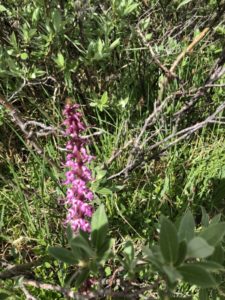Few natural wonders make me happier than clouds in August. Lately we’ve had more than a few, shielding us from what another poet has called the “bright stillness of noon.” And after spending a month with Wordsworth’s iconic poem, I’m still not sure why he linked the word lonely with the word cloud. On August 30, clouds look like a bunch of buddies in the sky.
But the word that caught my eye when I started learning this poem by heart was dance. It appears in some form four times, once in each stanza: “dancing,” “dance,” “danced,” and “dances.” The daffodils are dancing in the breeze, in a sprightly dance, the waves also danced, and then Wordsworth himself dances. Or, at least his heart dances (from his couch).
I Wandered Lonely as a Cloud
I wandered lonely as a cloud
That floats on high o’er vales and hills,
When all at once I saw a crowd,
A host, of golden daffodils;
Beside the lake, beneath the trees,
Fluttering and dancing in the breeze.
Continuous as the stars that shine
And twinkle on the milky way,
They stretched in never-ending line
Along the margin of a bay:
Ten thousand saw I at a glance,
Tossing their heads in sprightly dance.
The waves beside them danced; but they
Out-did the sparkling waves in glee:
A poet could not but be gay,
In such a jocund company:
I gazed—and gazed—but little thought
What wealth the show to me had brought:
For oft, when on my couch I lie
In vacant or in pensive mood,
They flash upon that inward eye
Which is the bliss of solitude;
And then my heart with pleasure fills,
And dances with the daffodils.
—William Wordsworth
The poem originated on a specific date, April 15, 1802, when Wordsworth and his sister, Dorothy, took a walk home in England’s Lake District and saw a bunch of daffodils. There were mountains in the distance.
The Writer’s Almanac says this, about that poetic day:
Dorothy wrote in her journal: ‘When we were in the woods beyond Gowbarrow park we saw a few daffodils close to the water side. We fancied that the lake had floated the seeds ashore and that the little colony had so sprung up. But as we went along there were more and yet more and at last under the boughs of the trees, we saw that there was a long belt of them along the shore, about the breadth of a country turnpike road. I never saw daffodils so beautiful they grew among the mossy stones about and about them, some rested their heads upon these stones as on a pillow for weariness and the rest tossed and reeled and danced and seemed as if they verily laughed with the wind that blew upon them over the lake, they looked so gay ever glancing ever changing.’
Don’t you think Dorothy should get partial credit for the poem?
Wordsworth didn’t write anything about the daffodils for at least two years, maybe longer. No one is sure when he sat down and actually penned the poem, which was published in 1807.
In fact, Dorothy is not the only woman who deserves a little creatorly love. So does Wordsworth’s wife, Mary. She wrote what Wordsworth considered the two best lines: “They flash upon that inward eye / Which is the bliss of solitude.”
I’m not here to cast aspersions regarding authorship, but it’s a good reminder that poems often result from group effort, whether acknowledged or not. I have grabbed many a detail from the Cornell Lab of Ornithology, for verisimilitude. And sometimes a stray comment at a coffee shop or a song lyric or even an object — like a flower — will dance its way into my heart and onto the page.
“I Wandered Lonely As A Cloud” is a poem I wrote about in The Joy of Poetry — about not understanding it. That is, not until I read Joyce Sutphen’s poem inspired by it, The Wordsworth Effect. But now that last stanza speaks to me without assistance.
Recently we were on vacation, and as usual, pictures were taken (before the buddy-buddy clouds turned into bringers of mayhem). My goal was to find one good one, to serve as my phone’s wallpaper.
The one with “wealth” always surprises me. The one that flashes “upon that inward eye” is never the one I expect. It’s the one specifically for the couch, when in “vacant or in pensive mood.” The one that will transport me back to that mountain path, strewn not with daffodils, but with elephantella.
Your Turn
Did you memorize “I Wandered Lonely As A Cloud” this month? Join our By Heart community and share your audio or video using the hashtags #ByHeart and #MemoriesWithFriends and tagging us @tspoetry. We also welcome photos of your handwritten copy of the poem.
By Heart for September
For the next By Heart gathering, September 27, we’ll learn “This Is Just To Say” by William Carlos Williams by heart.
This Is Just To Say
I have eaten
the plums
that were in
the icebox
and which
you were probably
saving
for breakfast
Forgive me
they were delicious
so sweet
and so cold
— William Carlos Williams
Photo by Pedro, Creative Commons, via Flickr. Post by Megan Willome.
Browse more By Heart
“Megan Willome’s The Joy of Poetry is not a long book, but it took me longer to read than I expected, because I kept stopping to savor poems and passages, to make note of books mentioned, and to compare Willome’s journey into poetry to my own. The book is many things. An unpretentious, funny, and poignant memoir. A defense of poetry, a response to literature that has touched her life, and a manual on how to write poetry. It’s also the story of a daughter who loses her mother to cancer. The author links these things into a narrative much like that of a novel. I loved this book. As soon as I finished, I began reading it again.”
—David Lee Garrison, author of Playing Bach in the D. C. Metro
- Perspective: The Two, The Only: Calvin and Hobbes - December 16, 2022
- Children’s Book Club: A Very Haunted Christmas - December 9, 2022
- By Heart: ‘The night is darkening round me’ by Emily Brontë - December 2, 2022



L.L. Barkat says
“Don’t you think Dorothy should get partial credit for the poem?”
Ha. 🙂 Why, yes, perhaps she should.
As for elephantella, I had to look it up (not realizing that that’s what that flower picture was in your post). What a whimsical flower! I’ve never heard of it, nor seen it.
https://www.ecosia.org/images?q=elephantella
Megan Willome says
I never had either, but it only grows in alpine environments, in this case over 10,000 feet above sea level (aka Megan’s happy place).